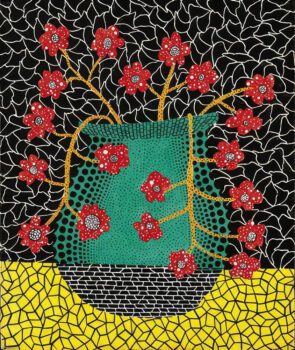Symbolism and Meaning of “A Flower”
In the vast cosmos of contemporary art, Yayoi Kusama is a dazzling star whose creative universe knows no limits. Among her many celebrated works, “A Flower” stands out as a deeply symbolic, visually hypnotic, and emotionally charged painting. While Kusama is most widely recognized for her polka dots, pumpkins, and immersive installations, her flower-themed works, especially A Flower, serve as a powerful window into her psyche, her past, and her philosophy. This story offers an in-depth analysis of A Flower by Yayoi Kusama, exploring its artistic context, its symbolism, how and when it was created, its significance, current location, and its valuation in the art world.
Who is Yayoi Kusama?
To understand A Flower, one must first understand the mind that birthed it. Yayoi Kusama, born in 1929 in Matsumoto, Japan, is one of the most important living artists in the world today. Her career spans over seven decades, and her influence bridges Eastern and Western art movements. Kusama is widely known for her avant-garde approach, which blurs the lines between painting, sculpture, performance, and installation.
Her signature motifs, polka dots, nets, and organic forms, stem from vivid hallucinations she has experienced since childhood. These hallucinations often involved patterns and shapes engulfing her surroundings, a phenomenon she later used as both a coping mechanism and an artistic language. Kusama voluntarily resides in a psychiatric hospital in Tokyo and continues to paint prolifically from her studio nearby. Her works, including A Flower, are inseparable from her personal struggles, mental health journey, and philosophy of self-obliteration and infinity.
What Is “A Flower” by Yayoi Kusama
“A Flower” is one of Kusama’s most iconic paintings from her botanical-themed works. Painted in 1983, the piece represents more than just flora, it is a manifestation of her lifelong relationship with hallucination, obsession, femininity, life, and death. While A Flower is only one among several Kusama flower works, it holds a unique position in her artistic evolution.
The painting features a stylized flower, bold and symmetrical, radiating a psychedelic aura with intricate detailing and saturated color. True to Kusama’s style, repetition and pattern dominate. The petals are meticulously adorned with polka dots and cellular patterns, giving the flower an almost biomorphic or alien appearance. The background, too, is often as involved as the subject, filled with netted patterns or dark voids, suggesting an infinite space around the organic form.
How Was “A Flower” Painted?
Yayoi Kusama is intensely methodical in her artistic process. A Flower was hand-painted using acrylic on canvas, a medium she has preferred for much of her career due to its vibrancy and speed of drying. Her process involves layering colors and lines over time, often working from memory and internal visions. Every dot and every contour is executed with obsessive precision.
The painting was likely created in her Tokyo studio after she returned from New York in the 1970s. Following her departure from the western art scene, Kusama retreated into a more introspective phase, focusing on literature, poetry, and painting. A Flower emerged during this era of prolific and personal output.
She described her working process during this period as a meditative ritual. Each stroke of the brush, each dot placed, was not only an act of artistic creation but also of psychological therapy, her way of confronting and neutralizing the hallucinations that haunted her.
What Is Happening in “A Flower”?
At first glance, A Flower appears deceptively simple, a large bloom centered in a kaleidoscopic or cosmic space. But the image pulses with deeper tension. The petals seem to expand outward endlessly, as though the flower is not a static object, but a living force pushing against the boundaries of the canvas.
There’s no background in the traditional sense. Instead, the space surrounding the flower is filled with intense repetition of form, dots, lines, and microscopic shapes, echoing both biological cells and cosmic constellations. This tension between the organic and the infinite is a hallmark of Kusama’s visual language.
In a metaphorical sense, the flower is not merely blooming, it is exploding, consuming, radiating. It is both a celebration of life and a reminder of death, representing the eternal cycle of birth and decay. Kusama’s flowers are not gentle or ornamental; they are aggressive, almost confrontational. They demand attention and provoke introspection.
Symbolism and Meaning of “A Flower”
Yayoi Kusama’s flowers carry profound symbolism. In Japanese culture, flowers are deeply linked to transience, especially cherry blossoms, which bloom beautifully and die quickly. Kusama taps into this cultural backdrop but transforms it into something more surreal and psychological.
1. Femininity and Sexuality:
Many scholars interpret her flower motifs as representations of female sexuality. The petals and central pistils are often exaggerated, eroticized, and magnified, sometimes resembling vulvas or reproductive organs. In this sense, A Flower can be viewed as an exploration of female identity, desire, and trauma.
2. Psychological Expression:
The repeating dots and cellular forms are direct visualizations of Kusama’s hallucinations. Rather than suppressing her mental illness, Kusama transforms it into art, making the flower a symbol of both suffering and resilience. The flower becomes a stand-in for her mind, unraveling, blooming, and reconstructing itself endlessly.
3. Infinity and Self-Obliteration:
Kusama has often said that her work is about dissolving herself into the universe. In A Flower, the expansion of petals and surrounding dots may represent this very act, the self obliterated into a pattern, becoming one with nature, time, and space.
4. Nature as a Portal to the Sublime:
While inspired by physical flowers, Kusama’s rendering of A Flower elevates the subject to something transcendent. It’s not a botanical study, but a spiritual experience. The flower represents a portal to the infinite, a single node in the vast interconnected web of existence.
What Type of Art Is “A Flower”?
“A Flower” by Yayoi Kusama belongs to multiple overlapping genres:
Contemporary Art: Created in the late 20th century, it reflects modern sensibilities and abstract forms.
Psychedelic Art: The use of vibrant colors, repeating motifs, and mind-altering composition gives it a psychedelic feel.
Feminist Art: With its possible references to female anatomy and empowerment, it aligns with themes explored by feminist artists.
Pop Art & Minimalism Influence: Kusama was briefly aligned with the Pop Art movement during her time in New York. Her obsession with repetition and everyday motifs like flowers also echoes minimalism and Pop Art aesthetics.
Surrealism: The dream-like, almost otherworldly interpretation of flowers and organic forms places it within the Surrealist tradition.
How Much Is “A Flower” by Yayoi Kusama Worth?
As of 2025, Yayoi Kusama is one of the highest-selling living female artists. Her artworks consistently break auction records. While A Flower has not publicly appeared in recent auctions, flower-themed paintings by Kusama have fetched between $1 million and $7 million USD depending on size, provenance, and exhibition history.
For example, a similar floral-themed canvas by Kusama sold at Christie’s for over $3.5 million in 2022. If A Flower were to be auctioned today, it would likely command a similar or higher price due to Kusama’s enduring popularity and the rarity of her early works.
Private collectors, museums, and major art institutions all compete for original Kusama pieces, which drives the prices even higher.
Where Is “A Flower” Located Today?
As of the most recent records, A Flower is held in the Yayoi Kusama Museum in Tokyo. Opened in 2017, the museum is a dedicated space for showcasing Kusama’s lifetime of works, including her paintings, sculptures, and installations. The museum rotates exhibitions regularly, and A Flower has been displayed in exhibitions centered on her flower motif and autobiographical works.
The museum was established by the Yayoi Kusama Foundation, and many of her most intimate works, like A Flower, are part of this institutional archive rather than in private hands. Occasionally, the painting may be loaned to other major international museums for retrospectives.
The Bloom Beyond the Canvas
“A Flower” by Yayoi Kusama is more than a painting, it is a visual echo of the artist’s soul. It stands as a confluence of beauty and torment, obsession and peace, the micro and the macro. Through the simplicity of a flower, Kusama explores themes that are deeply universal: the fragility of existence, the power of creation, and the infinite complexity of the human mind.
The flower is not merely blooming, it is becoming. It transforms before our eyes, asking us to look beyond surface beauty and into the darker, more intricate tapestry of human consciousness.
In Kusama’s world, even a single flower is a universe. And in A Flower, that universe pulses with life, pain, and transcendence.
Key Takeaways
“A Flower” by Yayoi Kusama was painted in 1983 using acrylic on canvas.
The painting reflects Kusama’s inner hallucinations, obsession with repetition, and psychological struggles.
It symbolizes femininity, life and death, the cosmos, and the idea of self-obliteration.
The work is housed in the Yayoi Kusama Museum in Tokyo, Japan.
Its estimated market value is in the range of $3–5 million or more.
The piece belongs to a mix of contemporary, feminist, psychedelic, and surrealist art genres.
“A Flower” is not just a painting, it is a mirror into Kusama’s visionary world. image/wikiart.org




